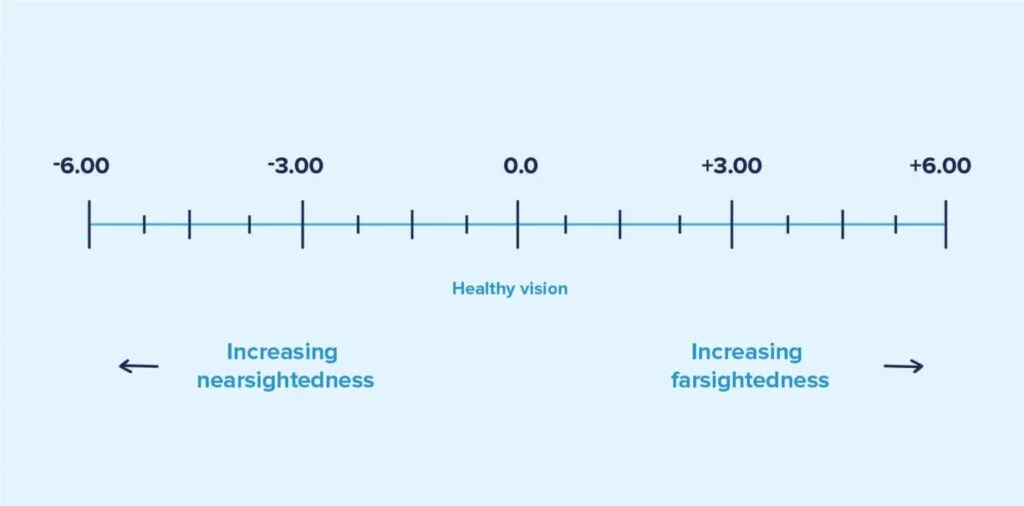Getting a new eye prescription can feel like deciphering a secret code. At EyeMantra Optical, we want to empower you with clarity and confidence by teaching you how to read your eye prescription. Below, we’ll explain common terms, guide you through interpreting your data, and help you use it wisely. Let’s explore everything you need to know.
Why You Need to Read Your Eye Prescription Correctly?
Understanding your prescription lets you order glasses tailored precisely to your vision needs. It ensures your lenses match your optometrist’s advice and avoids errors. You’ll know when it’s time for a new pair and be able to follow professional eye care recommendations accurately.
Key Abbreviations You’ll Find on Your Prescription
- OD (Oculus Dexter) – Indicates your right eye.
- OS (Oculus Sinister) – Refers to your left eye.
- OU (Oculus Uterque) – Means both eyes.
- SPH (Sphere) – Corrects nearsighted or farsighted vision in diopters.
- CYL (Cylinder) – Measurement for astigmatism correction.
- AXIS – Indicates the orientation (in degrees) of astigmatism correction.
- ADD – Added magnifying power for bifocals or reading.
- PD (Pupillary Distance) – The distance between the center of each pupil, vital for precise lens alignment.
How to Read Your Eye Prescription for Visual Clarity?
Understanding Sphere (SPH)
The SPH value shows how strong your lenses must be for overall vision correction. A negative (-) number denotes myopia (nearsightedness), and a positive (+) number indicates hyperopia (farsightedness). Larger numbers mean stronger correction is needed.
Interpreting Cylinder (CYL) & Axis
If your prescription includes CYL and AXIS, you have astigmatism, a distortion caused by an irregularly shaped cornea. CYL indicates its severity, and AXIS (1–180°) shows its orientation. If no astigmatism exists, these fields might be blank.
Decoding ADD for Reading or Progressive Lenses
The ADD value appears in multifocal prescriptions. It adds lens strength to aid near vision, making it essential for reading or computer work. Only progressive or bifocal users will see this.
Measuring Pupillary Distance (PD)
PD ensures your lenses align properly with your pupils. This measurement—often in millimeters—can appear as a single number (e.g., 62) or split values for each eye (e.g., 31/31). Precise PD helps avoid eye strain and ensures visual comfort.
Variants of “Read Your Eye Prescription” That People Search
To meet diverse search habits, here are popular keyword variations with good traffic:
- How to read your prescription for glasses
- Decode eye prescription abbreviations
- Understand your eyeglass prescription
- Interpret SPH CYL AXIS ADD PD numbers
- Read a prescription for nearsightedness and astigmatism
Using these naturally across paragraphs and headers broadens SEO reach.
What the Numbers Mean: An Example Prescription?
A typical chart reads like this:
- OD –2.00 SPH, –0.50 CYL × 90 AXIS
- OS –1.75 SPH, –0.25 CYL × 85 AXIS
- ADD +1.50
- PD 63
This indicates both eyes are nearsighted, with mild astigmatism and some reading correction. PD ensures proper lens alignment.
Why Accurate Lens Fitting Matters?
Correctly interpreting your prescription ensures lenses that meet your visual needs—from distance correction to reading enhancements. A wrong PD, misplaced axis, or incorrect ADD selection can worsen eye fatigue. At EyeMantra Optical, our opticians meticulously review and fit your lenses to prevent such issues.
Tips When You Read Your Prescription
- Watch for missing PD—ask your eye doctor if it’s not listed.
- Keep SPH, CYL, and AXIS values updated annually.
- Note that contact lens prescriptions use PD and BC (Base Curve), but differ slightly.
- Trust professionals for progression lining and lens coating recommendations.
Why Reading Your Eye Prescription Properly Enhances Eye Care?
Understanding your prescription empowers you when ordering glasses online or in-store. Knowing your exact SPH, CYL, AXIS, ADD, and PD helps you select lenses—whether single vision, bifocal, progressive, or blue-light blocking—tailored to your eyes and lifestyle. That insight keeps your vision sharp and your eyes at ease.
EyeMantra Optical & Hospital: Your Trusted Partners
At EyeMantra Optical, we go beyond selling eyewear. We’re part of EyeMantra Hospital, where qualified ophthalmologists and optometrists oversee your prescriptions and eye health. After your eye test, we decode your prescription, explain each value, and guide you through lens selection. Whether you need corrective, protective, or cosmetic eyewear, we ensure precision and understanding at every step.
Final Thoughts: Start Reading Your Eye Prescription Today
Once you learn how to read your eye prescription, you’ll navigate optical stores—online and offline—with confidence. You’ll make informed decisions, maintain optimal eye health, and choose lenses that truly correct your vision. If you have questions, our EyeMantra Optical team is always ready to clarify your values and recommend perfect lenses. Clear vision starts with clarity in your prescription.
